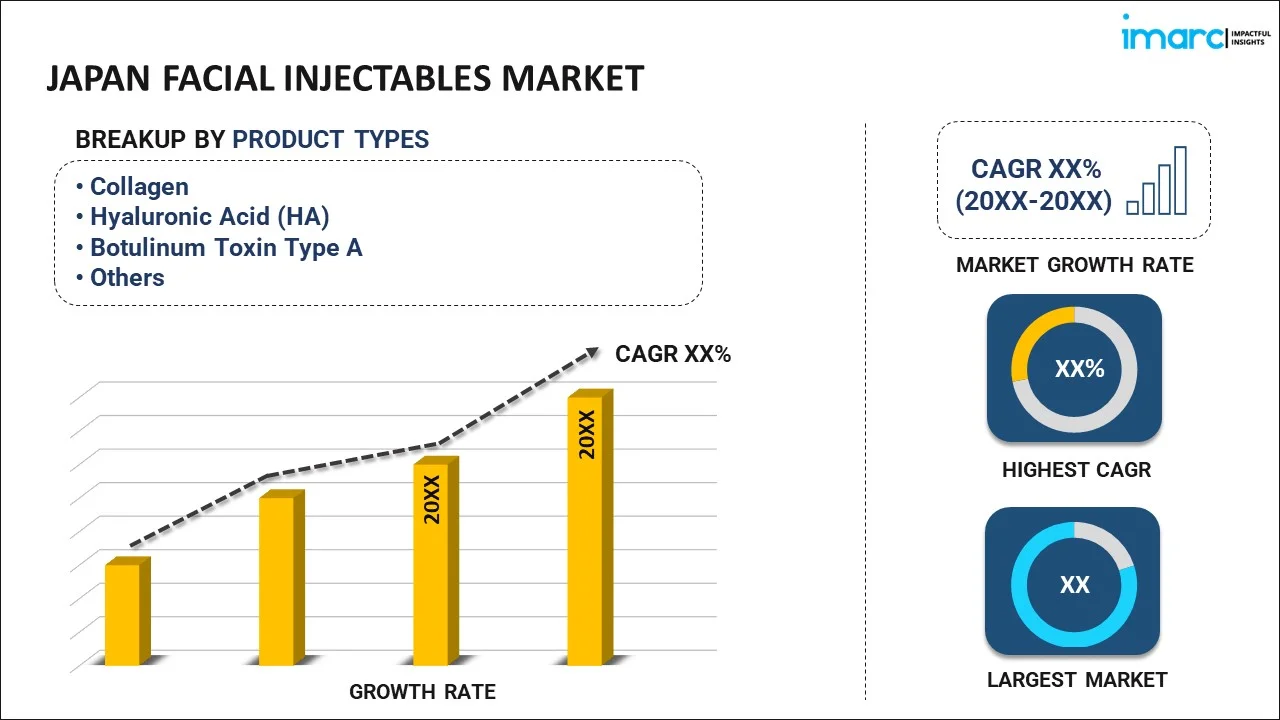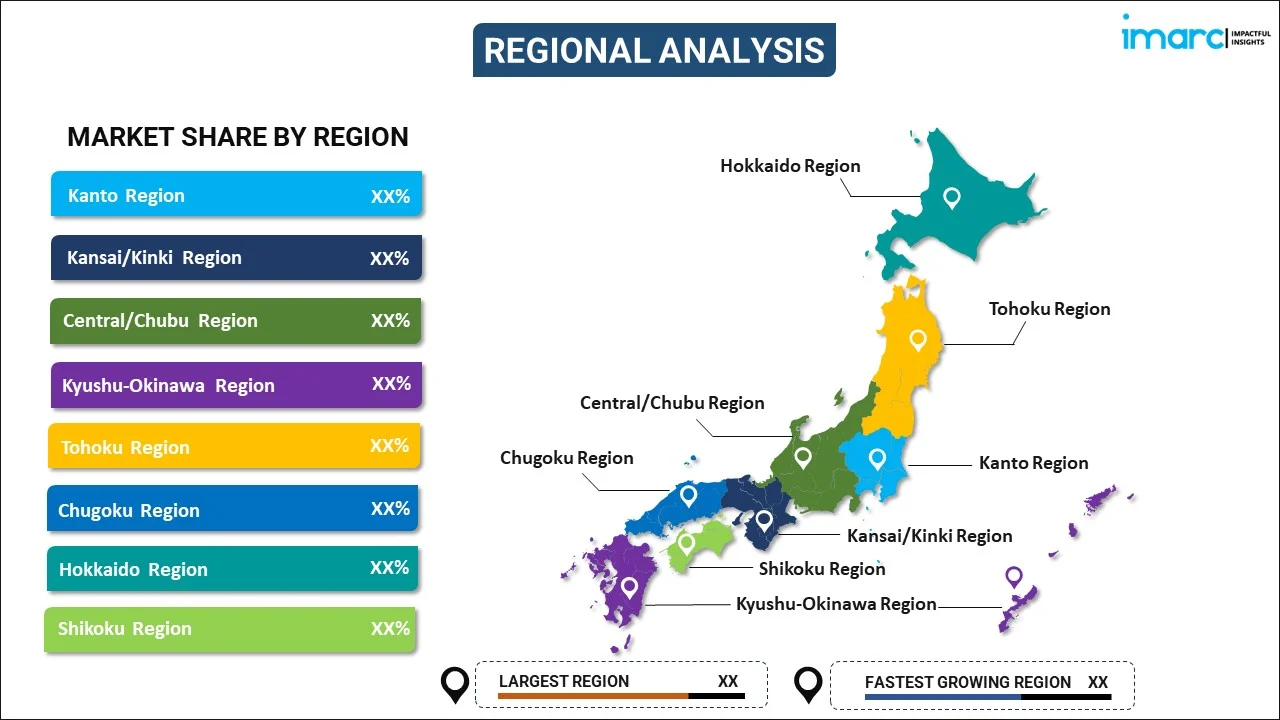
Japan Facial Injectables Market Report by Product Type (Collagen, Hyaluronic Acid (HA), Botulinum Toxin Type A, Calcium Hydroxylapatite (CaHA), Polymethylmethacrylate Beads (PMMA Microspheres), Poly-L-Lactic Acid (PLLA), and Others), Application Type (Aesthetics, Therapeutics), Application (Facial Line Correction, Lip Augmentation, Face Lift, Acne Scar Treatment, and Others), End User (Hospitals, Dermatology Clinics, and Others), and Region 2025-2033
Market Overview:
Japan facial injectables market size reached USD 404.8 Million in 2024. Looking forward, IMARC Group expects the market to reach USD 953.2 Million by 2033, exhibiting a growth rate (CAGR) of 9.23% during 2025-2033. The increasing demand for non-surgical treatments over invasive surgical procedures on account of their several benefits, like lower risk, shorter recovery time, and reduced cost, is driving the market.
|
Report Attribute
|
Key Statistics
|
|---|---|
|
Base Year
|
2024 |
|
Forecast Years
|
2025-2033
|
|
Historical Years
|
2019-2024
|
| Market Size in 2024 | USD 404.8 Million |
| Market Forecast in 2033 | USD 953.2 Million |
| Market Growth Rate (2025-2033) | 9.23% |
Facial injectables, often referred to as dermal fillers or wrinkle relaxers, have revolutionized the field of cosmetic enhancement. These non-surgical treatments offer a quick and effective way to rejuvenate the face, restoring a youthful appearance without the need for invasive surgery. Dermal fillers, typically composed of hyaluronic acid or other safe substances, are injected into specific areas of the face to add volume, smooth wrinkles, and enhance contours. They can plump up lips, soften lines, and restore lost facial volume, providing natural-looking results that can last for several months to a year. On the other hand, wrinkle relaxers work by temporarily paralyzing the underlying muscles responsible for facial wrinkles, smoothing out fine lines, and preventing the formation of new ones. This procedure is particularly effective for treating dynamic wrinkles caused by repetitive facial expressions. Facial injectables are administered by trained professionals, and the treatments are relatively quick with minimal downtime, making them a popular choice for those seeking to refresh their appearance without the risks and recovery associated with surgery.
Japan Facial Injectables Market Trends:
The facial injectables market in Japan is experiencing robust growth due to several key drivers. Firstly, the rising regional aging population is a significant factor. As individuals age, they seek non-invasive solutions to combat signs of aging, such as wrinkles and fine lines. Consequently, this demographic shift fuels the demand for facial injectables. Moreover, the increasing influence of social media and the constant pursuit of youthful aesthetics drive the market further. As people increasingly showcase their appearances online, the pressure to maintain a youthful look encourages them to turn to injectable treatments. Additionally, technological advancements in the field of cosmetic dermatology play a pivotal role. With continuous innovation, facial injectables have become safer, more efficient, and less painful, thereby attracting a larger consumer base. Furthermore, the expanding disposable income and growing awareness about aesthetic procedures among consumers boost market growth. This financial capacity enables more individuals to afford these treatments and view them as viable options for enhancing their appearance. In conclusion, the facial injectables market in Japan is expected to be driven by an aging population, social media influence, technological advancements, and increasing disposable income.
Japan Facial Injectables Market Segmentation:
IMARC Group provides an analysis of the key trends in each segment of the market, along with forecasts for the country level for 2025-2033. Our report has categorized the market based on product type, application type, application, and end user.
Product Type Insights:

- Collagen
- Hyaluronic Acid (HA)
- Botulinum Toxin Type A
- Calcium Hydroxylapatite (CaHA)
- Polymethylmethacrylate Beads (PMMA Microspheres)
- Poly-L-Lactic Acid (PLLA)
- Others
The report has provided a detailed breakup and analysis of the market based on the product type. This includes collagen, hyaluronic acid (HA), botulinum toxin type A, calcium hydroxylapatite (CaHA), polymethylmethacrylate beads (PMMA microspheres), poly-l-lactic acid (PLLA), and others.
Application Type Insights:
- Aesthetics
- Therapeutics
A detailed breakup and analysis of the market based on the application type have also been provided in the report. This includes aesthetics and therapeutics.
Application Insights:
- Facial Line Correction
- Lip Augmentation
- Face Lift
- Acne Scar Treatment
- Others
The report has provided a detailed breakup and analysis of the market based on the application. This includes facial line correction, lip augmentation, face lift, acne scar treatment, and others.
End User Insights:
- Hospitals
- Dermatology Clinics
- Others
A detailed breakup and analysis of the market based on the end user have also been provided in the report. This includes hospitals, dermatology clinics, and others.
Regional Insights:

- Kanto Region
- Kansai/Kinki Region
- Central/ Chubu Region
- Kyushu-Okinawa Region
- Tohoku Region
- Chugoku Region
- Hokkaido Region
- Shikoku Region
The report has also provided a comprehensive analysis of all the major regional markets, which include Kanto Region, Kansai/Kinki Region, Central/ Chubu Region, Kyushu-Okinawa Region, Tohoku Region, Chugoku Region, Hokkaido Region, and Shikoku Region.
Competitive Landscape:
The market research report has also provided a comprehensive analysis of the competitive landscape. Competitive analysis such as market structure, key player positioning, top winning strategies, competitive dashboard, and company evaluation quadrant has been covered in the report. Also, detailed profiles of all major companies have been provided.
Japan Facial Injectables Market Report Coverage:
| Report Features | Details |
|---|---|
| Base Year of the Analysis | 2024 |
| Historical Period | 2019-2024 |
| Forecast Period | 2025-2033 |
| Units | Million USD |
| Scope of the Report | Exploration of Historical and Forecast Trends, Industry Catalysts and Challenges, Segment-Wise Historical and Predictive Market Assessment:
|
| Product Types Covered | Collagen, Hyaluronic Acid (HA), Botulinum Toxin Type A, Calcium Hydroxylapatite (CaHA), Polymethylmethacrylate Beads (PMMA Microspheres), Poly-L-Lactic Acid (PLLA), Others |
| Application Types Covered | Aesthetics, Therapeutics |
| Applications Covered | Facial Line Correction, Lip Augmentation, Face Lift, Acne Scar Treatment, Others |
| End Users Covered | Hospitals, Dermatology Clinics, Others |
| Regions Covered | Kanto Region, Kansai/Kinki Region, Central/ Chubu Region, Kyushu-Okinawa Region, Tohoku Region, Chugoku Region, Hokkaido Region, Shikoku Region |
| Customization Scope | 10% Free Customization |
| Post-Sale Analyst Support | 10-12 Weeks |
| Delivery Format | PDF and Excel through Email (We can also provide the editable version of the report in PPT/Word format on special request) |
Key Questions Answered in This Report:
- How has the Japan facial injectables market performed so far and how will it perform in the coming years?
- What has been the impact of COVID-19 on the Japan facial injectables market?
- What is the breakup of the Japan facial injectables market on the basis of product type?
- What is the breakup of the Japan facial injectables market on the basis of application type?
- What is the breakup of the Japan facial injectables market on the basis of application?
- What is the breakup of the Japan facial injectables market on the basis of end user?
- What are the various stages in the value chain of the Japan facial injectables market?
- What are the key driving factors and challenges in the Japan facial injectables?
- What is the structure of the Japan facial injectables market and who are the key players?
- What is the degree of competition in the Japan facial injectables market?
Key Benefits for Stakeholders:
- IMARC’s industry report offers a comprehensive quantitative analysis of various market segments, historical and current market trends, market forecasts, and dynamics of the Japan facial injectables market from 2019-2033.
- The research report provides the latest information on the market drivers, challenges, and opportunities in the Japan facial injectables market.
- Porter's five forces analysis assist stakeholders in assessing the impact of new entrants, competitive rivalry, supplier power, buyer power, and the threat of substitution. It helps stakeholders to analyze the level of competition within the Japan facial injectables industry and its attractiveness.
- Competitive landscape allows stakeholders to understand their competitive environment and provides an insight into the current positions of key players in the market.
Need more help?
- Speak to our experienced analysts for insights on the current market scenarios.
- Include additional segments and countries to customize the report as per your requirement.
- Gain an unparalleled competitive advantage in your domain by understanding how to utilize the report and positively impacting your operations and revenue.
- For further assistance, please connect with our analysts.
 Inquire Before Buying
Inquire Before Buying
 Speak to an Analyst
Speak to an Analyst
 Request Brochure
Request Brochure
 Request Customization
Request Customization




.webp)




.webp)












